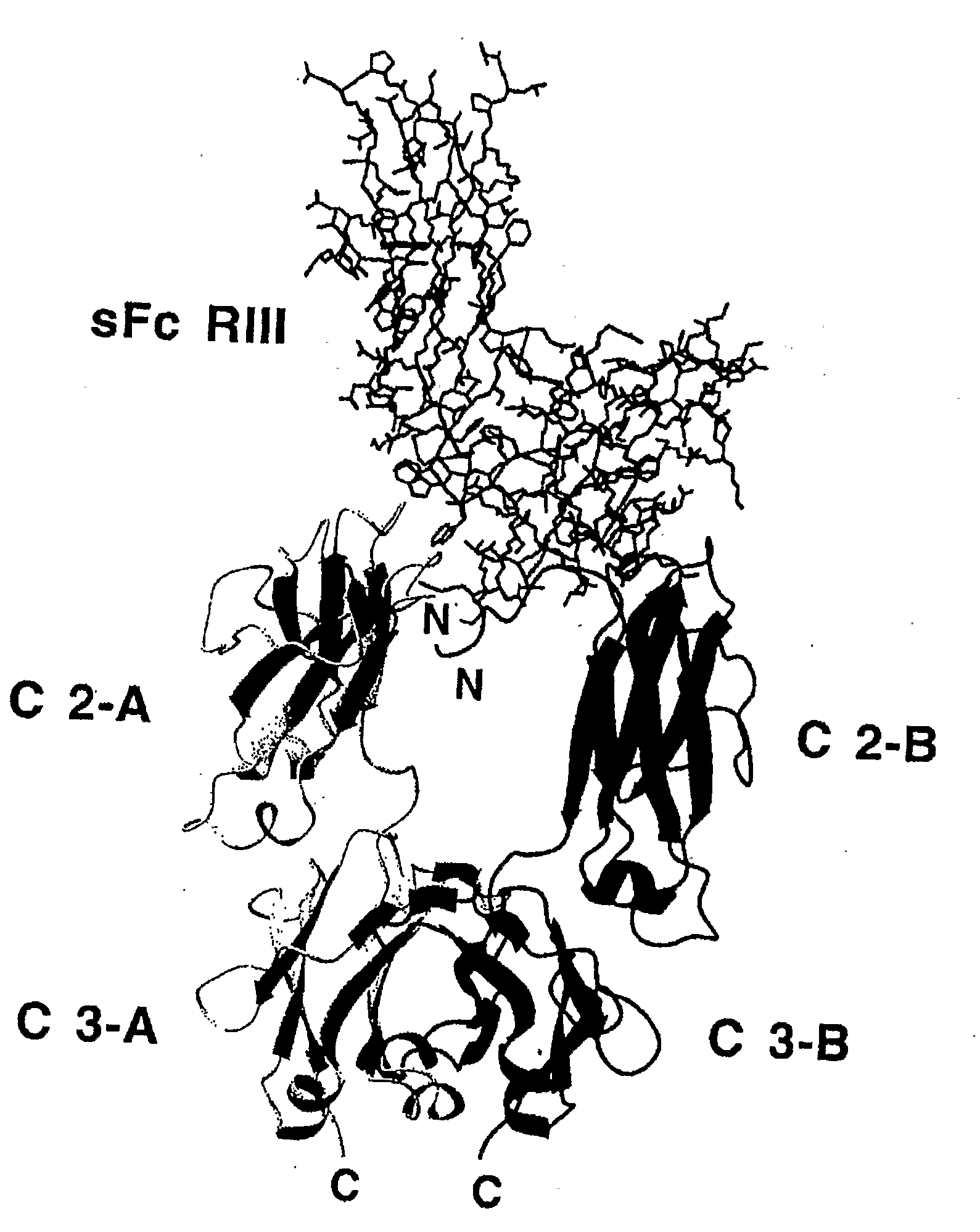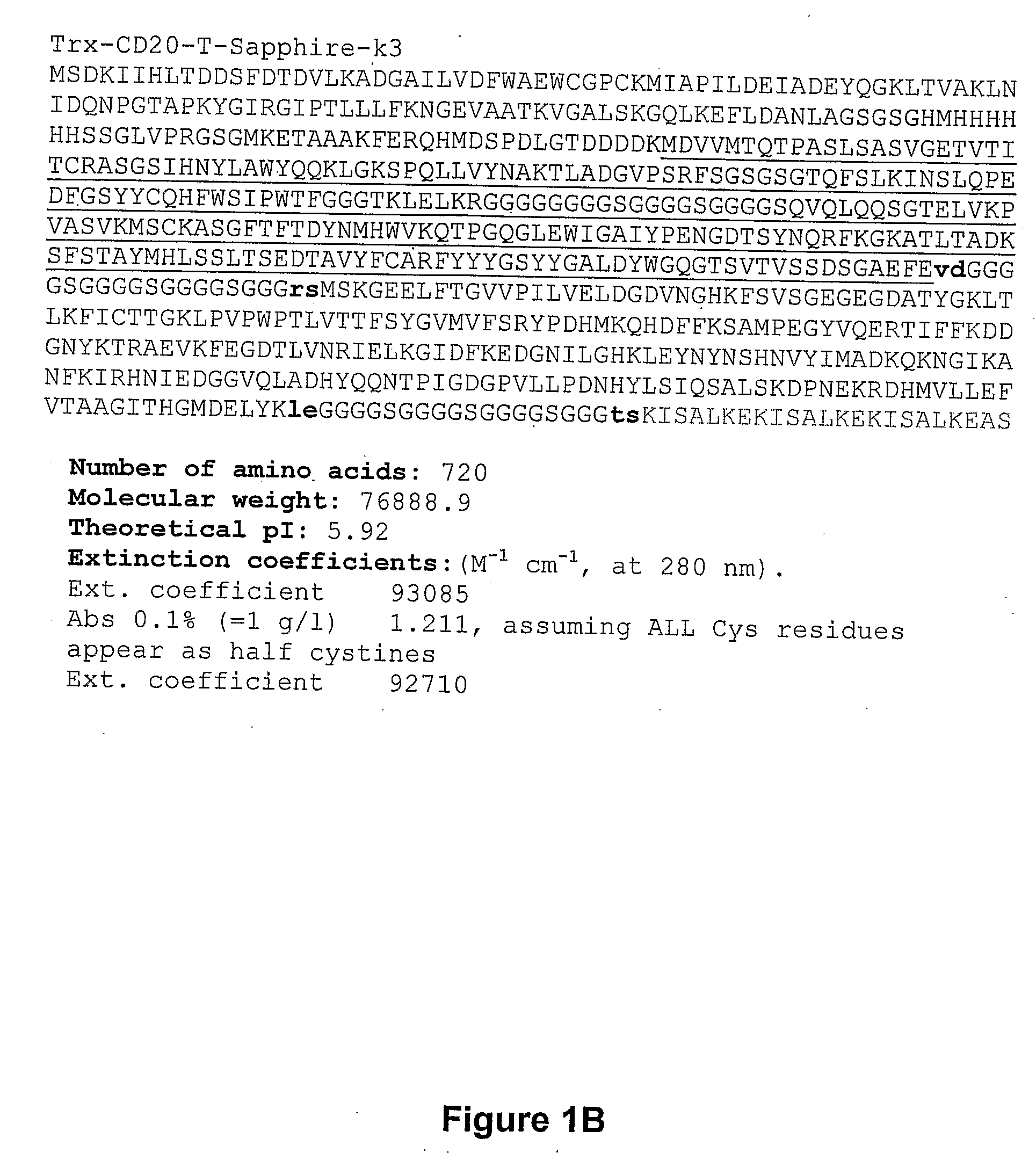Demibodies: dimerization-activated therapeutic agents
- Summary
- Abstract
- Description
- Claims
- Application Information
AI Technical Summary
Benefits of technology
Problems solved by technology
Method used
Image
Examples
example 1
Generation of Demibodies
[0168]The genes encoding DBA and DBB were synthesized (Schemes 1 and 2) and cloned into the pET32a vector to generate pET32a-30103s1, and pET32a-30103s2. After transformation into E. coli BL-21(DE3), several colonies from each transformation were selected, and tested for protein expression. The appearance of a band at ˜78 kDa from an induced sample was taken to represent the successful expression of the proteins and highly expressing colonies (colony 5 for pET32a-30103s2, and colony 3 for pET32a-30103s2) were used in successive expression experiments (FIGS. 2A, B). In both cases the proteins were expressed as inclusion bodies so after large-scale expression (1 L), the proteins were purified by metal affinity chromatography under denaturing conditions, and refolded to yield a final protein concentration of 0.1 and 0.9 mg / mL for Trx-DBA and Trx-DBB, respectively. The refolded proteins were ˜80% pure as judged by SDS-PAGE (FIG. 2C).
Scheme 1: DNA sequence of synt...
example 2
Expression and Purification
[0178]Subcloning 30103 S1 into pET32 Vector[0179](1) The 30103 S1 gene was synthesized and cloned to pET32 vector using Kpn I and Hind III.[0180](2) The resulted clone pET-30103 S1 was verified by DNA sequencing.
Transformation of E. coli BL-21(DE3)[0181](3) Five nanogram of the pET-30103 S1 plasmid was transformed into E. coli BL-21(DE3).[0182](4) Three colonies were selected. These clones were inoculated and grown in LB media and induced by 0.5 mM / L IPTG for 4 hr at 37° C. The expression results were detected by SDS-PAGE (12% w / v) (FIG. 7). Colony 3 was selected for future expression.
Optimization
[0183](5) The fusion protein was expressed at 25° C. and 15° C. The results are shown in FIG. 8.
Protein Expression
[0184](6) The E. coli strain was cultured in 1 L LB media for 4 hours and then induced by 0.5 mM / L IPTG for a further 4 hours at 37° C.[0185](7) The cells were harvested by centrifugation. The cell paste was resuspended in 70 mL PBS and then sonicated ...
example 3
Expression and Purification
[0190]Subcloning 30103 S2 into pET32 Vector[0191](1) The 30103 S1 gene was synthesized and cloned to pET32 vector using Kpn I and Hind III.[0192](2) The resultant clone pET-30103 S2 was verified by DNA sequencing. Transformation of E. coli BL-21(DE3)[0193](3) Five nanogram of the pET-30103 S2 plasmid was transformed into E. coli BL-21(DE3).[0194](4) Seven colonies were selected. These clones were inoculated and grown in LB media and induced by 0.5 mM / L IPTG for 4 hr at 37° C. The expression_results were detected by SDS-PAGE (12% w / v) (FIG. 10). Colony 5 was selected for future expression.
Optimization
[0195](5) The fusion protein was expressed at 25° C. and 15° C. The results are shown in FIG. 11.
Protein Expression
[0196](6) The E. coli strain was cultured in 1 L LB media for 4 hours and then induced by 0.5 mM / L IPTG for a further 4 hours at 37° C.[0197](7) The cells were harvested by centrifugation. The cell paste was resuspended in 70 mL PBS and then sonica...
PUM
| Property | Measurement | Unit |
|---|---|---|
| Structure | aaaaa | aaaaa |
| Therapeutic | aaaaa | aaaaa |
| Fluorescence | aaaaa | aaaaa |
Abstract
Description
Claims
Application Information
 Login to View More
Login to View More - R&D
- Intellectual Property
- Life Sciences
- Materials
- Tech Scout
- Unparalleled Data Quality
- Higher Quality Content
- 60% Fewer Hallucinations
Browse by: Latest US Patents, China's latest patents, Technical Efficacy Thesaurus, Application Domain, Technology Topic, Popular Technical Reports.
© 2025 PatSnap. All rights reserved.Legal|Privacy policy|Modern Slavery Act Transparency Statement|Sitemap|About US| Contact US: help@patsnap.com



